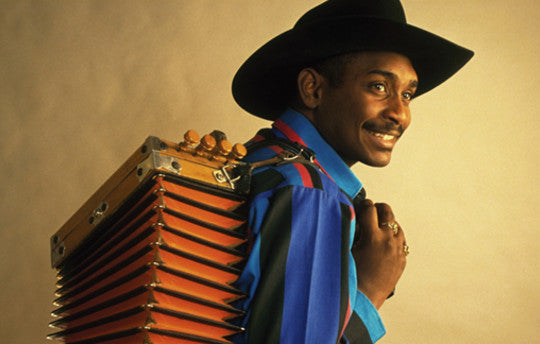Your Cart is Empty

Louisiana is renowned for the hardness of life and the spiciness of the cuisine. Its music shares both characteristics, with high, searing vocals backed by accordion, violin, and guitar, and waltzes and two-steps that in turn sparkle with a determined gaiety or convey bleakness and tragedy.
The word Cajun comes from the Louisiana Acadiens, whose ancestors were the French settlers forced out of North America by the colonising British and who travelled down the Mississippi River to start a new life. Establishing themselves as the dominant clique amongst the other European and Afro-Caribbean groups of the area, their roots are not forgotten with the existence of many French equivalents to old Cajun folk songs. Essentially though, music has always been a release for Cajun communities. As leading accordion player Marc Savoy puts it; ‘They’re interested in the atmosphere this music creates, so that they can socialise, so they can drink and relate to one another. Music is the glue that holds the whole culture and society together’.
What is now thought of as the typical Cajun ensemble has its beginnings in the 1920s, when the fiddle began to share the solos with the accordion, and the guitar and triangle were for rhythmic backing. The first Cajun recordings were made around the same time by the accordionist Joseph Falcon, and his guitarist wife Cleoma, such as ‘Allons a Lafayette’ in 1928.
In the 1930’s the younger generation of Cajuns yearned for ‘acculturation’ into the English-dominated U.S.A, and as a result a new style of Cajun music began to emerge, influenced by the hillbilly music and western swing heard on the radio. The leaders of this new style were The Hackberry Ramblers, and along with other new bands, they were fiddle and guitar led, boasting drum kits and electric steel guitars.
After World War II there was a revival of homegrown culture and with it the soul of Cajun music returned. Dancehalls were packed to see musicians such as Harry Choates, Chuck Guillory, and probably the most famous Cajun accordionist, Iry LeJeune, whose son Eddie continues his work today.
Cajun’s greatest ambassadors and the group that long represented the quintessential Cajun sound was the Balfa Brothers, made up of brothers Will and Dewy on the fiddle and Rodney on the guitar. Alongside accordionists like Hadley Fontenot and Nathan Abshire, the group played a repertoire that was a glossary of Cajun’s all-time greats and traveled to festivals in the US and abroad. There are now many who were close to this group who have continued the Cajun renaissance by setting up music centres, such as accordionist Marc Savoy, or simply playing high quality traditional Cajun music like the group Beausoleil.
At the other end of the scale from Savoy and the purists, there are many commercially successful groups and musicians who have fused Cajun music with blues, rock and country such as Zachery Richard, File and Jo-El Sonnier.
The Creole Sound: La-La and Zydeco
The old-style dance music of the Creoles, Louisiana’s black population, was known as La-La, less prettily melodic than Cajun and with accordion, fiddle and rhythm on the washboard. Accordionist Amédé Ardoin was at the forefront of this style and his recordings had a huge influence on Cajun music, also revealing that black and white music during the 1930’s and 40’s had much in common; indeed, Ardoin’s best –known collaborator was white fiddler Dennis McGee.
La-La blended with blues, rock and other popular forms to become zydeco, the contemporary style of which dates from the post-war years. Its development and popularity can largely be credited to accordionist Clifton Chenier (1925-1987) who recorded over 100 albums in thirty years of this bluesy and rock- based zydeco sound, led by accordion and backed by heavy drums, guitar, electric bass, sometimes with saxophone or brass.
The sound has gone from strength to strength, with top-class players a virtual guarantee in the zydeco clubs near Lafayette over the weekend. Some of these artists include the Queen of zydeco Queen Ida, Boozoo Chavis and Rockin’ Sidney along with the today’s most successful group Buckwheat Zydeco.